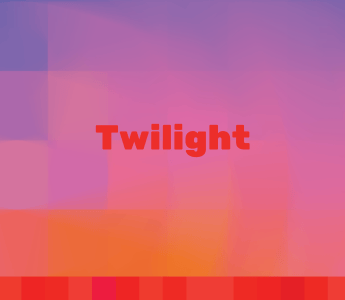
As an introduction to our 2024 program of events, Writers Victoria’s Program and Partnerships Manager, Anna Kate Blair, writes below about our 2024 theme: TWILIGHT.
oh! that the time comes
when hearts are aflame
– Arthur Rimbaud, borrowed as an
epigraph by Éric Rohmer, and now by me
In summer, twilight comes late. I’m impatient for it, for the softness and relief that it provides after the heat of the day. I feel safer, venturing out, less likely to be sunburnt; I walk to the water and watch the silhouettes of swimmers against the sea, sparkling orange and purple. There is a lightness that comes when the temperature inside your body matches the temperature outside it, as if the boundary between self and world has melted away.
~
Will it sound as if we’re headed toward death? somebody asked, as we tossed around ‘twilight’ as a potential theme. Will people expect vampires? I don’t mind either possibility. Multiplicity and ambiguity, after all, are integral to writing; it’s a delight to have a theme that encourages us toward both sixteenth-century astronomy and twenty-first century kitsch.

I love the melancholy evoked by the word ‘twilight’ – the day is ending, after all – and I love the way that this dissipates as soon as the metaphor is investigated: night is full of pleasures, and twilight is its overture.
~
There’s the obvious film, called Twilight, but there many slightly less obvious films, about twilight. I’ve been thinking, since we chose this theme, of Éric Rohmer’s Le Rayon Vert, from 1986, about a girl who tries to go on holiday and really struggles with it.
Delphine, at the beginning of the film, interviews people about their vacations and makes plans for her own. She goes to Cherbourg with a friend’s family, but feels like an interloper; she goes to the Alps and hikes beside a dirty glacier, gazing bored at nearby mountaintops. She goes to Biarritz, alone, and meets a Swedish girl whose playful energy exacerbates her own ennui. She overhears a group discussing Jules Verne’s The Green Ray and learns of the phenomenon for which it is named, an optical refraction in which the sun’s last ray of light appears as a neon green bar blinking on the horizon.
~
In Verne’s novel, a group of people search for the green ray, linked to a Scottish legend in which those who see the ray will be incapable of deception in matters of love. Helena, the book’s protagonist, is romantically pursued by a scientist and an artist. The scientist explains the mathematics behind the green ray, rendering it a brutal optical phenomenon. It is poetry that Helena loves, though, and she rejects the man who has overexplained the magic of a sunset.
She might have forgiven him anything but this, Verne writes.
Helena’s party continue searching. Twilight, in their conception, can change everything. The horizon, though, is endlessly obscured by clouds, by birds, by the sails of boats. The green ray appears, eventually, but Helena has fallen in love with the artist, is gazing into his eyes instead of out at the horizon, and she misses it entirely.
~
Delphine, however, doesn’t miss the green ray.

Le Rayon Vert has lessons for writers, I think; it’s important to be patient, to make efforts to investigate one’s desires and one’s world, to learn to control one’s perspective. Delphine is travelling alone, and doesn’t need to fulfil anyone else’s desires, fit into a pre-existing form. She has freedom and psychological space, which open up the possibility of further exploration. I hope that our workshops can operate in the way that waiting, listening and observing operate for Delphine, gently guiding her and constructing a philosophy, enriching her understanding of the world even as she appears aimless.
~
Mosab Abu Toha on William Wordsworth:
When he’s talking about the sun, it’s the same sun.
~
Corina Copp, who wrote a book of poetry entitled The Green Ray, notes that Rohmer’s film attempts to search or write toward an object that is ultimately fleeting and elusive […] almost as a prop so we can discover something else. I am using the green ray, now, as a prop to think about twilight, and about writing. Tacita Dean, who made another film with the same title, noted that looking for the green ray becomes about the act of looking itself, about faith and belief in what you see. We want to grasp it, to write or film it, because it feels ungraspable. It is always on the horizon that we can’t reach.
~
A most wonderful green, a green which no artist could ever obtain, wrote Jules Verne.
~
Love is the green in green. Does this explain its pain? writes Fanny Howe.
~
In writing, we often try to reach something that evades us. Literature is, like any art, closely involved with illusion, evocation, reaching toward horizons. I feel this, writing now, wishing I could grasp an idea just slightly beyond my sentences. I am gesturing at a connection between writing and twilight, between this idea of the green ray and creative workshops, but I can’t seem to articulate it. It twinkles, at the edge of vision, vanishing before I know its shape.
~

~
Twilight can wake us up to the delights of the night, but it can also be a reminder to rest, an invitation to close our eyes. I am writing this on my fifth day of coronavirus, and so it’s a drowsier, draftier piece than I’d anticipated. It is, I think, unfinished.
I am writing, though, to writers, and so I don’t need to be the one to finish this, to articulate these ideas. This piece comes at the end of 2023, but it is an introduction to 2024, and so of course it isn’t finished; it is a beginning. It is, like twilight, a mess of clouds and the day’s final rays of light, something that you can take in different directions or overlook entirely.
We would quickly be bored, I think, if we were satisfied with our writing, if it felt final. It might be better, perhaps, to see writing as akin to the sunset that marks twilight’s arrival, something that can be constant and predictable yet shifts and changes, a spectacle on the horizon; there are clouds, sometimes, but also glitter, a green ray.
Explore the 2024 Season 1 Program by downloading a PDF of the program here, or visiting our events calendar here.
